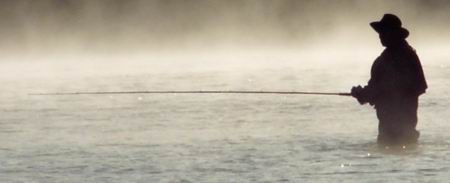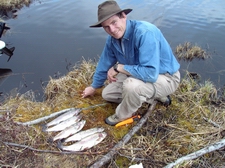Hook, Line and Mikkelsen..Diary of a P.G. Angler
By 250 News

-by Glen Mikkelsen
Parasites in Tabor Lake!?
What’s growing in Tabor Lake? Global warming may be inducing global worming!
On the last weekend in April, my fishing friend Rob and I tried Tabor Lake for some early-spring fishing. It was a sunny afternoon, and we fished from 3:00 pm to 6:00 pm.
Intererstingly, the lake was quiet. With the ice recently off the lake, we anticipated a greater number of anglers on the water. As it was, we saw three other boats. Most of these anglers were trolling.
We may have discovered why more people are not fishing Tabor Lake.
I rigged up my 6-weight fly rod with a floating line, strike indicator, and black chironomid fly with a silver bead. Setting the chironomid’s depth at about three feet, I had a strike on the second cast.
Immediately the rainbow trout jumped. It was spunky, lively, and keen, but on bringing it into the net, we noticed white marks on the trout’s fins and body.
We felt these spots must be an anomoly, and continued casting. The day turned out to be out best ever on Tabor Lake. I continued to use chironomids, and Rob used mini-leeches. We caught no northern pike minnows (squaw fish), but hooked trout only. We pulled in over half a dozen trout each, and had just as many strikes.
However, all of the trout brought in had these white spots. With our curiousity piqued, with closer examination, the spots were all living parasites. Some trout had more than others on their body, but they all had them. They somewhat resembled fish lice, but did not have a saucer-shape.
Returning home to find out the answer, I phoned the local B.C. fisheries office. It appears the trout are likely infected by a species of salmincola. This external parasite attaches to the fins, mouth, or gills of trout.
The salmincola, are a crustacean parasite. They appear more often in warm water lakes. These lakes will contain an abundance of waterfowl and weed growth (both of which Tabor Lake contains), essential to the salmincola’s life cycle. As the salmincola mature, the free swimming larva will attach themselves to fish.
It is believed trout will sometimes leap out of lakes, crashing back on to the water, in attempts to dislodge the parasites. This may be true, as on other evenings, Tabor Lake has been alive with jumping trout. They were not eating aggressively, but seemed to be intent on other items of concern.
According to the parasite information I researched, it is safe to eat the fish infected by salmincola. There is no reported health risk. However, hot smoking will not kill the parasites. To ensure a their well-being, anglers should properly freeze or cook the fish.
Specifically, if your home freezer is set at –4 degrees F, it is recommended your fish is frozen five to seven days to kill the parasites.
Freezing does not guarantee the parasites are dead, but with proper cooking, parasite survival is reduced.
And what is proper cooking? Fish should be cooked until the fish flakes completely, and there is no translucence. The internal meat temperature must reach 180 degrees F. The meat must be 140 degrees F through the entire fish to kill parasites, and 180 degrees F to kill any bacteria.
Frankly though, although I kept one fish, it lost its appetizing qualities after learning more about salmincola. The fish seemed healthy, but their appearance diminished the fish’s appeal on closer inspection. This is a shame considering the proximity of Tabor Lake, and its fishing potential.
With salmincola most common in warmer summer waters, it was strange that they were on Tabor fish just after the ice thawed. Nevertheless, that seems to be the best diagnosis of the creatures we found.
Does this mean other Northern lakes are also infected? Is it a sign of warmer weather patterns, creating new issues for northern fauna?
If other anglers are finding similar parasites in other lakes, tell us about them. Drop us your line at talk@opinion250.com , and let us know what you are finding on your hooks!
Till then,
Glen
Sooner or later, every angler has their day!
From being lost on the Kalum River, to landing a Mexican sailfish, Glen Mikkelsen finds adventures with a fishing rod in hand. In twenty years of publications, he’s written for B.C. Sportfishing, Canadian Sportfishing, and even a couple of books on chuckwagon racing. And Mikkelsen believes that sooner or later, every angler has their day.
Previous Story - Next Story
Return to Home










